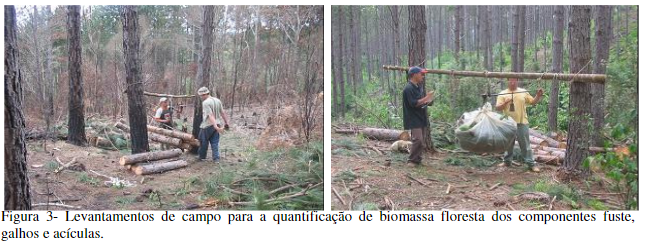Biomass inventory in a Pinus elliottii engelm plantation. at 23 years old
DOI:
https://doi.org/10.20873/jbb.uft.cemaf.v2n3.giongoKeywords:
planted forests, modeling, biomassAbstract
Above ground dry biomass was estimated for a 23 years old Pinus elliottii stand, located at Rio Branco do Sul, State of Paraná, Brazil. Stem, branches and needles dry biomass were estimated separately. The estimated total above ground dry biomass was composed by 85 % of stem, 10 % of branches and 5 % of needles, respectively. The adjusted equation for estimation of total dry biomass as a function of the diameter at breast height (DBH), showed a coefficient of determination (R²) of 0.91 and a standard error in percentage (Sxy%) of 11,98 %. Among the tested models for estimating the different portions of tree dry biomass as a function of DBH, the stem biomass equation was the one that showed the best results.
References
Balbinot, R.; Valério, Á. F.; Sanquetta, C. R.; Caldeira, M. V. W.; Silvestre, R. (2008), Estoque de carbono em plantações de Pinus spp. em diferentes idades no sul do Estado do Paraná. Floresta, 38, 317-324.
Balbinot, R.; Schumacher M. V.; Watzlawick, L. F.; Sanquetta, C. R. (2003), Inventário do carbono orgânico em um plantio de Pinus taeda aos 5 anos de idade no Rio Grande do Sul. Revista Ciências Exatas e Naturais, 5, 59-68.
Hoeflich, V. A.; Alves, M. V. G.; Koehler, H. S.; Medrado, M. J. S. (2005), The Brazilian forest sector: challenges and strategies for its development. In: XXII IUFRO World Congress, Brisbane, Queensland.
Hoeflich, V. A.; Alves, M. V. G.; Tuoto, M. A. M.; Koehler, H. S. (2007), Challenges and strategies for the development of brazilian forest sector. In A Global Vision of Forestry in the 21st Century, Toronto.
Kengen, S. (2001), La Política Forestal Brasileña: Un breve histórico. Simposio Iberoamericano de Gestión y Economia Forestal. Porto Seguro, Bahia.
Martins, F. B.; Páscoa, M. F. M.; Silva; J. C. (2004), Modelos de estimativa de biomassa para acículas de Pinus pinaster Aiton. In: 3º Simpósio Latino-Americano sobre Manejo Florestal, Santa Maria, 49-54.
Peel, M. C.; Finlayson, B. L.; McMahon, T. A. (2007), Updated world map of the K¨oppen-Geiger climate classification. Hydrology and Earth System Sciences, 11,1633-1644.
Pellico Netto, S. e Brena, D. A. (1997), Inventário Florestal. Curitiba: Editorado pelos autores, 316 p.
Ritson, P. e S. Sochacki. (2003), Measurement and prediction of biomass and carbon content of Pinus pinaster trees in farm forestry plantations, south-western Australia. Forest Ecology and Management, 175, 103-117.
Salati, E. (1994), Emissão e seqüestro de CO2 - Uma nova oportunidade de negócios para o Brasil. In: Seminário Emissão e Seqüestro de CO2 – Uma nova oportunidade de negócios para o Brasil. Rio de Janeiro, 15-37.
Sanquetta, C. R. (2002), Métodos de determinação de biomassa florestal. In: As florestas e o carbono. Curitiba, 119-140.
SFB. Floresta do Brasil em resumo - 2010: dados de 2005-2010. Brasília-DF: SFB. 152p.
Watzlawick, L. F.; Koehler, H. S.; Kirchner, F. F. (2004), Estimativa de biomassa e carbono em plantios de Pinus taeda L. utilizando imagens de satélite IKONOS II. In: 3º Simpósio Latino-Americano sobre Manejo Florestal, Santa Maria, 168-178.

Published
How to Cite
Issue
Section
License
Copyright (c) 2024 - Journal of Biotechnology and Biodiversity

This work is licensed under a Creative Commons Attribution 4.0 International License.
Authors who publish with this journal agree to the following terms:
Authors retain copyright and grant the journal right of first publication with the work simultaneously licensed under a Creative Commons Attribution License (CC BY 4.0 at http://creativecommons.org/licenses/by/4.0/) that allows others to share the work with an acknowledgement of the work's authorship and initial publication in this journal.
Authors are able to enter into separate, additional contractual arrangements for the non-exclusive distribution of the journal's published version of the work (e.g., post it to an institutional repository or publish it in a book), with an acknowledgement of its initial publication in this journal.
Authors are permitted and encouraged to post their work online (e.g. in institutional repositories or on their website) prior to and during the submission process, as it can lead to productive exchanges, as well as earlier and greater citation of published work (Available at The Effect of Open Access, at http://opcit.eprints.org/oacitation-biblio.html).


